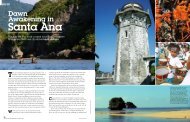Cut off from the rest of the country, and shrouded by storms, Batanes ...
Cut off from the rest of the country, and shrouded by storms, Batanes ...
Cut off from the rest of the country, and shrouded by storms, Batanes ...
Create successful ePaper yourself
Turn your PDF publications into a flip-book with our unique Google optimized e-Paper software.
LOCAL BaTaneS foR BegInneRS<br />
“you have good timing,” our innkeeper, Manang Lydia<br />
Roberto said <strong>of</strong> our arrival, as she supervised her waitstaff<br />
with our breakfast <strong>of</strong> fried rice <strong>and</strong> fried flying fish dipped in<br />
vinegar <strong>and</strong> <strong>Batanes</strong>’ strong garlic. Apparently, this is <strong>the</strong> perfect<br />
time to travel to <strong>the</strong>se parts. Unlike <strong>the</strong> <strong>rest</strong> <strong>of</strong> <strong>the</strong> philippines,<br />
<strong>Batanes</strong> has practically four seasons. Because it’s so<br />
far up north, its climate is more temperate than <strong>the</strong> <strong>rest</strong> <strong>of</strong> <strong>the</strong><br />
<strong>country</strong>. In what locals like to call winter (yes, winter!), cold air<br />
traveling down <strong>from</strong> Siberia, China, <strong>and</strong> Taiwan goes down<br />
to <strong>Batanes</strong>. Taiwan is a near neighbor, separated only <strong>by</strong> <strong>the</strong><br />
Bashi Channel. In fact, <strong>the</strong> Ivatans are close kin to <strong>the</strong> Tao<br />
people <strong>of</strong> Orchid Isl<strong>and</strong>, Taiwan’s sou<strong>the</strong>rnmost territory.<br />
“It’s great that it’s sunny, but I’d love for you to experience<br />
a storm here,” said newly elected Basco mayor demy<br />
Narag later when we met up with him. “Storms are different in<br />
<strong>Batanes</strong>.” How different? you only have to look at <strong>the</strong> traditional<br />
Ivatan stone houses, which have thick walls to keep away<br />
<strong>the</strong> cold winds <strong>and</strong> rain in winter to realize that <strong>the</strong> wea<strong>the</strong>r can<br />
get pretty extreme. And what happens in winter, we asked <strong>the</strong><br />
mayor. “we close our windows,”<br />
he said, smiling. The best time<br />
to be here though is in summer,<br />
roughly March-June, when <strong>the</strong><br />
wea<strong>the</strong>r is relatively mild. The <strong>rest</strong><br />
<strong>of</strong> <strong>the</strong> time, <strong>the</strong> wea<strong>the</strong>r is apt to<br />
change <strong>from</strong> rainy to sunny at <strong>the</strong><br />
drop <strong>of</strong> a hat.<br />
Surprisingly, “we get a lot <strong>of</strong><br />
local tourists,” mayor demy told<br />
us. “The ones who like to see<br />
untouched or unusual places.”<br />
<strong>Batanes</strong> has <strong>the</strong>se in abundance.<br />
Being away <strong>from</strong> it all is part <strong>of</strong><br />
<strong>Batanes</strong>’ allure, <strong>and</strong> jaded city-<br />
(THIS page fRom Top) THe RoLLIng<br />
HILLS <strong>of</strong> “maRLBoRo counTRy”; one <strong>of</strong><br />
BaTaneS’ oLdeST ReSIdenTS weavIng<br />
a HaT; cLay jaRS <strong>of</strong> taru (SugaRcane<br />
vInegaR); (oppoSITe page, cLockwISe<br />
fRom Top) a STone HouSe In SaBTang,<br />
fLoweRS By THe RoadSIde; anoTHeR<br />
STONE hOUSE<br />
dwellers will certainly feel recharged here.<br />
wide-open spaces, <strong>and</strong> a 360º vista<br />
ensure that even <strong>the</strong> most stressed-out<br />
urbanite will be able to slow down. In<br />
<strong>the</strong> 2002 census, <strong>Batanes</strong> had less than<br />
20,000 people spread over some 200<br />
square kilometers. Untouched rolling hills<br />
<strong>and</strong> cliffs just beg to be climbed, <strong>and</strong> kilometers<br />
<strong>of</strong> open road are perfect for cyclists<br />
<strong>and</strong> road-trippers. Just get on your<br />
vehicle <strong>of</strong> choice <strong>and</strong> explore. Or just opt<br />
to walk around, even though distances<br />
between townships can be daunting to<br />
walk for people used to <strong>the</strong> convenience<br />
<strong>of</strong> small city blocks. however, you won’t<br />
have trouble getting <strong>from</strong> one place to<br />
<strong>the</strong> next. There is ample transportation<br />
around. And it’s practically a rule on <strong>the</strong><br />
isl<strong>and</strong>s for motorists to give people <strong>the</strong>y<br />
meet on <strong>the</strong> road a lift, as we tried to do<br />
with a group <strong>of</strong> kids walking home <strong>from</strong><br />
school. But <strong>the</strong> kids, shy <strong>of</strong> strangers,<br />
politely declined, preferring to walk <strong>the</strong><br />
long way home.<br />
The isl<strong>and</strong>s that comprise <strong>Batanes</strong><br />
have a different topography <strong>from</strong> <strong>the</strong><br />
<strong>rest</strong> <strong>of</strong> <strong>the</strong> <strong>country</strong>. By some geographical<br />
quirk, <strong>the</strong> province feels more like<br />
<strong>the</strong> Orkneys in Nor<strong>the</strong>rn Scotl<strong>and</strong>, with<br />
its craggy cliffs <strong>and</strong> rolling hills, than <strong>the</strong><br />
philippines. Batan <strong>and</strong> Sabtang isl<strong>and</strong>s<br />
have gentle rolling hills <strong>and</strong> slopes <strong>and</strong><br />
friendly beaches. Meanwhile, Itbayat, <strong>the</strong><br />
most remote <strong>of</strong> <strong>the</strong> three, has no natural<br />
shoreline <strong>and</strong> is full <strong>of</strong> craggy cliffs, prompting someone in our group to quip,<br />
“It’s not a good idea to go to Itbayat when you’re depressed. you just might<br />
jump <strong><strong>of</strong>f</strong> one <strong>of</strong> <strong>the</strong> cliffs!”<br />
The second day, we crossed to Sabtang on a fallowa, an outriggerless<br />
boat common in <strong>Batanes</strong>. while most <strong>of</strong> us were accustomed to riding<br />
outriggers in our travels around <strong>the</strong> <strong>country</strong>, it was a bit daunting to be in<br />
a small craft in <strong>the</strong> open sea without <strong>the</strong> slim protection <strong>of</strong>, well, <strong>the</strong> actual<br />
outriggers to balance our weight. But our guides say fallowas can ride <strong>the</strong><br />
waves <strong>and</strong> outriggers are not ideal for <strong>Batanes</strong>’ choppy waters. An hour<br />
later, a bit deaf <strong>from</strong> <strong>the</strong> loud engine <strong>and</strong> more than a little nauseous <strong>from</strong><br />
<strong>the</strong> engine fumes <strong>and</strong> <strong>the</strong> swaying <strong>of</strong> <strong>the</strong> boat, we hit l<strong>and</strong>. Immediately, we<br />
spied a picturesque lighthouse on a cliff, one <strong>of</strong> several such structures dotting<br />
<strong>the</strong> province.<br />
The famous Ivatan stone houses in barangay Savidug were our first<br />
stop. Though a lot <strong>of</strong> Ivatans have modern houses, especially in <strong>the</strong> capital,<br />
many <strong>of</strong> <strong>the</strong>se stone dwellings are still inhabited <strong>by</strong> locals. Savidug looks like<br />
a place where time stood still. Except for occasional reminders <strong>of</strong> modern living—a<br />
sari-sari store sign, <strong>and</strong> radios in some houses—<strong>the</strong> village must have<br />
looked <strong>the</strong> same a century ago. what adds to <strong>the</strong> aura <strong>of</strong> being str<strong>and</strong>ed<br />
in time is <strong>the</strong> fact that <strong>the</strong> village <strong>and</strong> <strong>the</strong> <strong>rest</strong> <strong>of</strong> Sabtang only get 12 hours<br />
<strong>of</strong> electricity daily, <strong>rest</strong>ricting access to a lot <strong>of</strong> modern conveniences. Many<br />
<strong>of</strong> <strong>the</strong>se houses were built during <strong>the</strong> latter part <strong>of</strong> <strong>the</strong> 19th century with <strong>the</strong><br />
help <strong>of</strong> masons <strong>and</strong> carpenters <strong>from</strong> Cagayan valley. Traditionally two-stories<br />
high, <strong>the</strong> houses have meter-thick cogon ro<strong>of</strong>s that can last decades <strong>and</strong><br />
meter-thick walls <strong>of</strong> pulverized limestone. Locals quarry <strong>the</strong> rock, which are<br />
<strong>the</strong>n burned at high temperatures <strong>and</strong> pulverized. The resulting powder is<br />
mixed with cogon grass <strong>and</strong> used to plaster <strong>the</strong> walls. Not far <strong>from</strong> Savidug<br />
we chanced upon an archeological dig <strong>of</strong> a burial site jointly sponsored <strong>by</strong><br />
<strong>the</strong> University <strong>of</strong> <strong>the</strong> philippines, <strong>the</strong> National Museum, <strong>and</strong> <strong>the</strong> Australian<br />
National University. The scientists were on a break so <strong>the</strong>y didn’t mind showing<br />
us around <strong>the</strong>ir campsite.<br />
60 travelife NOVEMBER-DECEMBER 2007 www.travelife.biz www.travelife.biz NOVEMBER-DECEMBER 2007 travelife 61





